Making Pasta Sauce
Created: 2010-04-11 05:55:46
Over the years I have made pasta sauce that, although based on tomatoes, contained a number of other ingredients such as onion, chillies, herbs, ginger even sugar, salt and vinegar. I now make it with tomatoes alone, it still last well but allows the final ingredients to be added to the sauce so it can be varied, depending on your tastes.
I was lucky enough to be able to buy a small box of Roma tomatoes from our local green grocer quite cheaply, it has not been a good year for tomatoes at our place.
I got a heavy, four litre pot and then filled it to the brim with tomatoes, and just a bit of water in the bottom to start the process off. A heavy pot is good for this type of work because it diffused the head and reduces the risk of the sauce catching. If you only have thin walled pots you can still buy a steel heat and flame diffuser from kitchen shops that will also reduce the likelihood of catching, in the old days when I was a kid they were made from asbestos.
I just covered the pot and set it to a low heat and went about other things. An hour later I checked and it was simmering nicely, I used a potato masher to push the tomatoes down and mash them up, and added more tomatoes to bring the pot back to full. After another hour I removed the lit and let is simmer uncovered for another couple of hours to concentrate the sauce.
I let it cool and then put it through a Porkert brand “fruit press” that I bought from a kitchen shop. You put the tomato mix in the top and turn the handle, the good stuff is forced through a strainer and the seeds and skins come out the front. The seeds and skins are then given to the worms.
Once strained I pack the sauce off into clean recycled glass jars with “pop top” lids, the lids being only screwed on lightly. I then stood the jars back in the pot, filled it with water and boiled the full jars for an hour or so. They could then be lifted out carefully and placed on a tea towel on the sink to cool, after tightening up the lids. When the lids pop down with a “thunk” they are properly sealed and will last at room temperature in the cupboard. Label and date and they are ready for storage or use.

